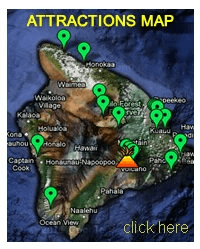Big Island of Hawaii Attractions
 The Big Island of Hawaii lives up to its name as it is much bigger than all the other Hawaiian Islands, home to the largest telescope in the world, the tallest mountain in the world (when measured from its base at the ocean floor), the largest contiguous ranch in the United States and one of the largest and most active volcanoes in the world.
The Big Island of Hawaii lives up to its name as it is much bigger than all the other Hawaiian Islands, home to the largest telescope in the world, the tallest mountain in the world (when measured from its base at the ocean floor), the largest contiguous ranch in the United States and one of the largest and most active volcanoes in the world.
Big Island attractions are therefore unique and plentiful, from stunning green-, black- and red-sand beaches, waterfalls and rainforests to wide open spaces that can’t be found anywhere else in Hawaii.
A Big Island sightseeing tour can be an exciting adventure, as in one single day you can experience a swim in the warm ocean and after that walk in snow (during the winter months) on top of the island’s highest peak. Below is a list of some of the best things to do on the Big Island of Hawaii.

Ala Kahakai National Historic Trail
The Ala Kahakai Trail is a 175-mile (282 km) long trail that runs along much of the Big Island's west and south shores. The trail was established as a National Historic Trail as a way to access and preserve Hawaiian culture.

Big Island Candies
Established in 1977, Big Island Candies is the oldest, biggest and probably best-known sweets shop on the island. The most popular items are their chocolate-dipped shortbread cookies and chocolate-covered macadamia nuts.

Captain Cook Monument
The Captain Cook Monument is a major landmark on the Kona Coast. Rising up against the sky, the tall white spire strikes a beautiful contrast against its natural surroundings - the rugged ground, the high cliffs and the lush vegetation.

Hilo Coffee Mill
Stop by this coffee farm to sample their excellent coffees grown right here on this 24-acre farm. Tours are being offered as well, where you can see how they roast and package their coffees. Other gift items are available in the visitor store.

Hawaii Volcanoes National Park
Look into the mouth of one of the world's most active volcanoes at the Hawaii Volcanoes National Park. It encompasses 377 square miles (976 sq. km) and is the number one visitor attraction in the entire state of Hawaii.

Hilo Clock
This clock was hit by the 1960 tsunami and since then stands with its hands frozen in time – 1:04 a.m. Townspeople refurbished it, but decided against restoring it to working order in honor of those who perished in the tidal waves.

Kaimu Beach Eco-Path
This hike leads through a lava field that was created by the 1990 eruption of Kilauea volcano, which destroyed the ancient Hawaiian fishing village of Kalapana and the Royal Gardens subdivision.

King Kamehameha Statue
The King Kamehameha Statue stands proudly near downtown Hilo in the Wailoa River State Park. It is one of four statues of King Kamehameha I. This statue in Hilo measures 14 feet (4.3 m) tall and is the tallest of the four statues of the king.

Manuka State Wayside Park
The Manuka State Wayside Park has a beautiful 8-acre arboretum, which contains 130 introduced exotic plants and flowers, as well as 48 species of native Hawaiian plants and trees.

Mauna Kea Observatory and Summit
Rising 13,796 feet (4205 m), Mauna Kea is the tallest peak in the Pacific and by some accounts, the tallest in the world when measured from its base, which is 18,000 feet (5486 m) below the sea. It is the best place in the world for stargazing.

Mauna Kea State Recreation Area
Located at 6,500 feet (1,981 m) elevation on Saddle Road, the 20.5-acre (82,960 sq. m) Mauna Kea State Recreation Area offers nice views of Mauna Kea and Mauna Loa. The park is mainly shrub land with picnicking and lodging opportunities.

Mauna Loa Macadamia Nut Company
Here's where you can literally go nuts! Located in Hilo, the Mauna Loa Macadamia Nut Company is a good place to visit if you like macadamia nuts and would like to learn more about the process of harvesting and processing them.

Pana'ewa Rainforest Zoo
Located in Hilo, this zoo is unique in that the animals live in a natural setting as they would in nature and are much less fenced in. The zoo prides itself as being "the only natural tropical rainforest zoo in the United States."

Pololu Valley
Pololu Valley is one of the most remote spots on the Big Island. Most visitors just come to the Pololu Valley Lookout, which overlooks the lush valley and sea cliffs. In the past, the valley was among the richest wetland taro plantations in Hawaii.

South Point - Ka Lae
South Point, known as Ka Lae in the Hawaiian language, is the southernmost tip of the Big Island of Hawaii, as well as the United States. Even though desolate, the landscape is beautiful in its own way.

Star of the Sea Painted Church
With frescos and stained glass adorning the interior, the Star of the Sea Painted Church boasts a history as colorful as its walls. The paintings tell the story of Father Damien, a Belgian priest who helped Hansen's disease patients on Molokai.

Thurston Lava Tube
The Thurston Lava Tube, also called Nahuku, is one of the magnificent sights located within the Hawaii Volcanoes National Park. Created over hundreds of years by volcanic activity, lava tubes are not uncommon in Hawaii.

Volcano Art Center
Located within Hawaii Volcanoes National Park, the Volcano Art Center Gallery features works from more than 300 local artists. The impressive collection includes island pottery, woodwork, paintings, photographs, jewelry, quilts and more.

Volcano Winery
Hawaii isn't known for producing wines, but the Big Island is home to the Volcano Winery, where visitors can sample and purchase unique Hawaiian fruit-blended wines with exotic names, such as Volcano Red and Volcano Blush.

Waikoloa Anchialine Pond Preservation Area
This series of brackish water lava pools are home to various small fishes, tiny red shrimp and crustacean mollusks. A trail leads from the roadside parking area to the ocean.

Waipi'o Valley
Waipio Valley on the Big Island's Hamakua Coast is the last and largest of the seven valleys east of the Kohala Mountains. Giant cliffs rising over 2,000 feet (610 m) surround the lush valley and give it an air of serenity, seclusion and mystery.









